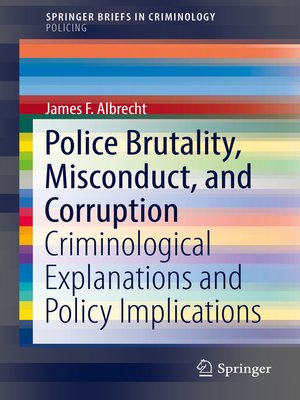Police Brutality, Misconduct, and Corruption
ebook ∣ Criminological Explanations and Policy Implications · SpringerBriefs in Criminology
By James F. Albrecht

Sign up to save your library
With an OverDrive account, you can save your favorite libraries for at-a-glance information about availability. Find out more about OverDrive accounts.
Find this title in Libby, the library reading app by OverDrive.



Search for a digital library with this title
Title found at these libraries:
| Library Name | Distance |
|---|---|
| Loading... |
This Brief proposes a criminological typology for understanding and addressing police misconduct. Through examination of each major type of police misconduct, the author proposes future research directions to deter and prevent misconduct.
According to an examination of 50 years of police misconduct cases within the New York Police Department (NYPD) and Los Angeles Police Department (LAPD), the author proposes 5 major typologies: police corruption, police criminality, excessive use of force, abuse of authority, and police misconduct. Through a systematic examination of each of these five types, the author aims to break down the nebulous topic of police misbehavior into manageable categories, with their own set of causes, and recommendations for detection and prevention.
This work will be of interest for researchers in criminology and criminal justice, particularly with an interest in police studies, and related fields such as public policy and sociology. It will alsobe of interest for policymakers.
According to an examination of 50 years of police misconduct cases within the New York Police Department (NYPD) and Los Angeles Police Department (LAPD), the author proposes 5 major typologies: police corruption, police criminality, excessive use of force, abuse of authority, and police misconduct. Through a systematic examination of each of these five types, the author aims to break down the nebulous topic of police misbehavior into manageable categories, with their own set of causes, and recommendations for detection and prevention.
This work will be of interest for researchers in criminology and criminal justice, particularly with an interest in police studies, and related fields such as public policy and sociology. It will alsobe of interest for policymakers.







